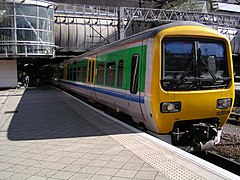British Rail Class 323
British electric multiple unit passenger train
The British Rail Class 323 electric multiple units were built by Hunslet TPL from 1992-96. Forty-three 3-car units were built for inner-suburban services around Birmingham and Manchester. These trains were the last vehicles to be built by the struggling manufacturer Hunslet before it collapsed.
| British Rail Class 323 | |
|---|---|
 West Midlands Railway Class 323 at Aston in 2019 | |
 Interior of a refurbished Arriva Rail North Class 323 unit | |
| In service | 7 February 1994 – present |
| Manufacturer |
|
| Order no. |
|
| Built at | Leeds[4] |
| Replaced | |
| Constructed | 1992–1995[4] |
| Refurbishment |
|
| Number built | 43[5] |
| Successor | Class 730 (West Midlands Railway)[6] |
| Formation | 3 cars per unit: DMS-TS-DMS[7] |
| Diagram |
|
| Fleet numbers | 323201–323243[7] |
| Capacity |
|
| Operator(s) | |
| Depot(s) |
|
| Line(s) served | |
| Specifications | |
| Car body construction | Aluminium alloy[3] |
| Train length | 70.18 m (230 ft 3 in) |
| Car length |
|
| Width | 2.800 m (9 ft 2.2 in) |
| Height | 3.769 m (12 ft 4.4 in) |
| Floor height | 1.156 m (3 ft 9.5 in) |
| Doors | Double-leaf sliding plug, each 1.305 m (4 ft 3.4 in) wide (2 per side per car) |
| Wheelbase | Over bogie centres: 16.000 m (52 ft 5.9 in) |
| Maximum speed | 90 mph (145 km/h)[7] |
| Axle load | Route Availability 3[12] |
| Traction system | |
| Traction motors | 8 × Holec DMKT 52/24[5] asynchronous three-phase AC |
| Power output | 1,168 kW (1,566 hp) total[12] |
| Electric system(s) | 25 kV 50 Hz AC Overhead |
| Current collection method | Pantograph (Brecknell Willis)[7] |
| UIC classification | Bo′Bo′+2′2′+Bo′Bo′ |
| Bogies | |
| Braking system(s) | Westcode EP (disc) and regenerative[7][note 5] |
| Safety system(s) | |
| Coupling system | Tightlock |
| Multiple working | Within class (max. 4 units)[7] |
| Track gauge | 1,435 mm (4 ft 8 1⁄2 in) standard gauge |
| Notes | |
| Sourced from Webber 1999 unless otherwise noted. | |

Notes
change- ↑ Hunslet Transportation Projects Limited (HTPL) sold its Birmingham-based design, engineering, and project management functions – including responsibility for the Class 157 and 323 contracts – to the Dutch electrical engineering firm Holec in March 1994.[1][2]
- ↑ Between Birmingham and Bromsgrove.[11]
- ↑ The Alstom IGBT system delivers improved reliability, though – in order to avoid the need for expensive recertification – it is configured to emulate as exactly as possible the control and electromagnetic interference characteristics of the original system.[13]
- ↑ Both types of bogie are derived from the British Rail Engineering Limited (BREL) BT13 design.[15] RFS Industries was formed in 1987 through a buy-out by former BREL managers of British Rail's Doncaster Wagon Works.[16]
- ↑ The regenerative system is the primary brake for the train in normal operation, blended with the friction brakes as required. Emergency braking uses the friction brakes alone, at a force 30% above the normal 'full service' application.[17]
References
change- ↑ Webber 1999, Table 1 'Chronology'. "Hunslet TPL (Engineering and Project Management) becomes Holec Ridderkerk (Birmingham) Limited, latterly Holec Ridderkerk UK Limited: 15 March 1994".
- ↑ Williams, Philip (23 March 1994). "Hunslet has had enough of 'misery line' battles". Birmingham Post. Midland Independent Newspapers. p. 9. Archived from the original on 23 September 2022. Retrieved 4 December 2022 – via Newspapers.com.
- ↑ 3.0 3.1 3.2 3.3 Fox, Peter (1994). British Railways Pocket Book No. 4: Electric Multiple Units (7th ed.). Sheffield: Platform 5 Publishing. pp. 38–39. ISBN 9781872524603.
- ↑ 4.0 4.1 "Class 323 Electric Multiple Unit Traction Upgrade". Institution of Mechanical Engineers. 5 May 2017. Archived from the original on 8 January 2022. Retrieved 7 January 2022.
- ↑ 5.0 5.1 5.2 5.3 5.4 5.5 "Class 323". Modern Locomotives Illustrated. No. 228. Stamford: Key Publishing. December 2017. pp. 49–53.
- ↑ "West Midlands Trains turns back the clock with retro repaint for Class 323". Today's Railways Uk. No. 252. February 2023. p. 55.
- ↑ 7.0 7.1 7.2 7.3 7.4 7.5 7.6 Class 323 Driver's Manual (PDF). Northern Rail Limited. 19 May 2013. Archived from the original on 30 August 2017. Retrieved 1 February 2016.
{{cite book}}: CS1 maint: unfit URL (link) - ↑ "New era of rail travel to begin as West Midlands Railway unveils electric train fleet". West Midlands Railway. 8 February 2024. Retrieved 8 February 2024.
- ↑ 9.0 9.1 "Class 323 EMUs to remain in traffic with Northern". Rail Magazine. No. 886. Peterborough: Bauer Consumer Media. August 2019. p. 30.
- ↑ "Manchester depot revitalised". Rail Magazine. No. 975. Peterborough: Bauer Consumer Media. 25 January 2023. p. 27.
- ↑ "Exploring the "Elgar Line" to Hereford". Today's Railways UK. No. 261. November 2023. pp. 40–47.
- ↑ 12.0 12.1 Class 323 Electric Multiple Unit (PDF) (1A ed.). Derby: Porterbrook Leasing Company. November 2013. pp. 16, 19–20. Archived from the original (PDF) on 23 November 2015. Retrieved 8 December 2022.
- ↑ 13.0 13.1 Walmsley, Ian (23 February 2017). "A Traction Heart Transplant". Modern Railways. Stamford: Key Publishing. Retrieved 29 November 2022.
- ↑ Marsden, C. J. (2007). "Class 323". Traction Recognition. Hersham: Ian Allan Publishing. pp. 184–185. ISBN 978-0-7110-3277-4. OCLC 230804946. OL 16902750M.
- ↑ Webber 1999, p. 56.
- ↑ "Catalogue Description: RFS Industries Ltd, Records 1987–1989". The National Archives. DZ MD/574. Retrieved 29 November 2022.
- ↑ Webber 1999, p. 59.